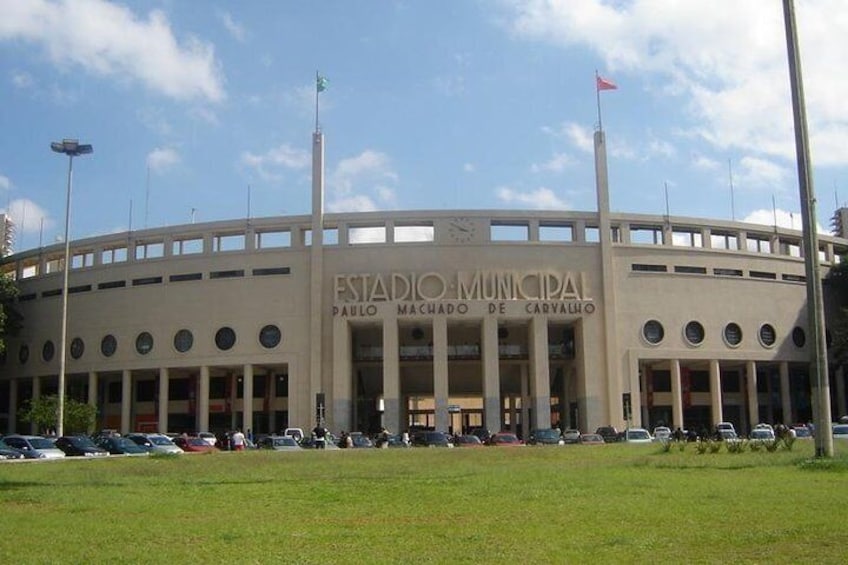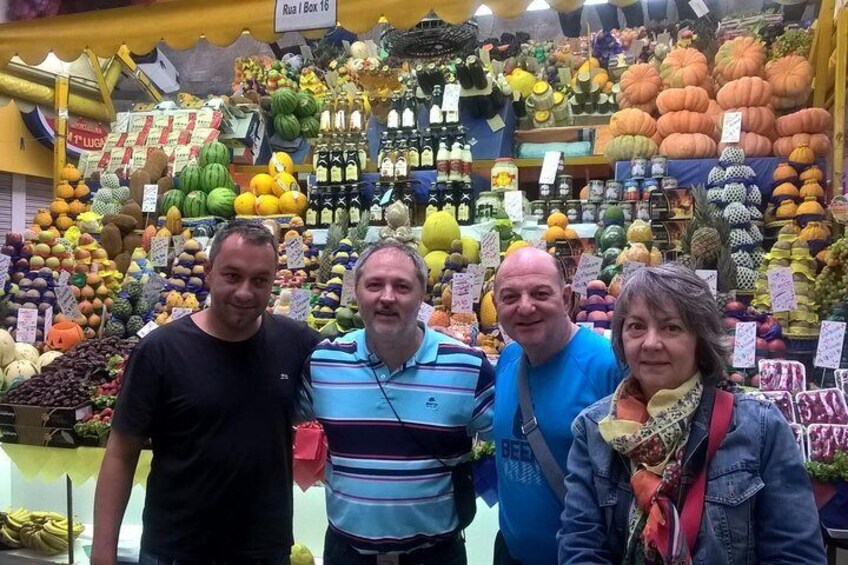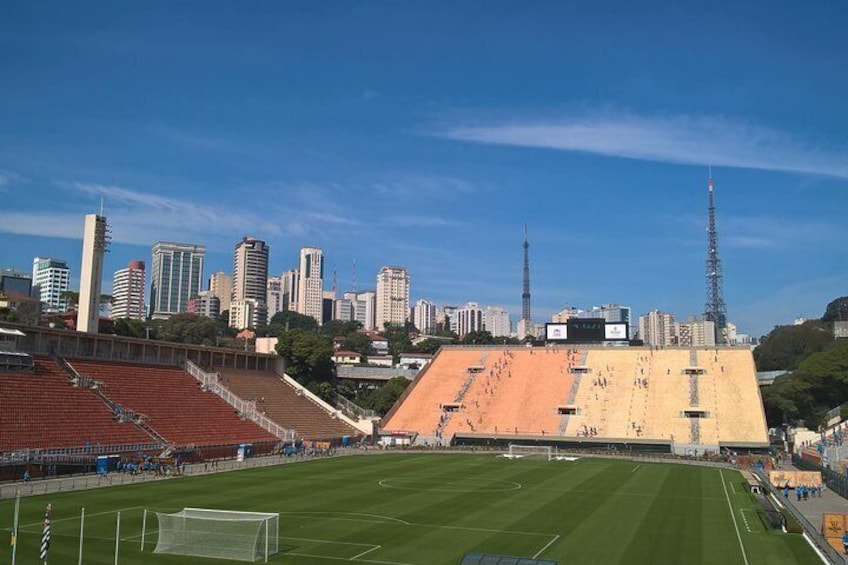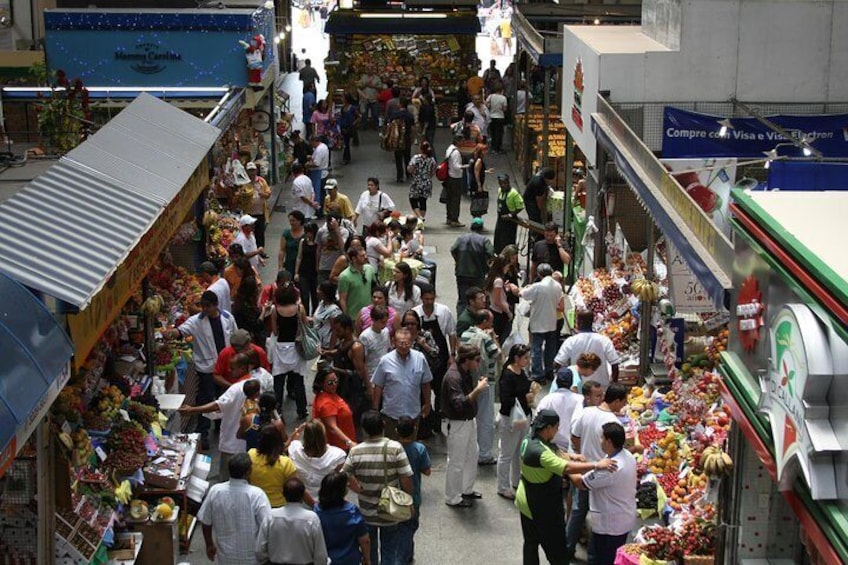List your propertySupportTrips Learn about Expedia Rewards
Learn about Expedia Rewards
Members save 10% or more on over 100,000 hotels worldwide when you’re signed in





São Paulo Private City Tour
By Salt and City Tours
8.8/10
8.8 out of 10Free cancellation available
per adult
Features
- Free cancellation available
- 4h
- Mobile voucher
- Instant confirmation
- Selective hotel pickup
- Multiple languages
Overview
This 4 hour private and exclusive city tour of São Paulo is suitable if you are in lay-over or taking a break from your hotel opting for an overview of the main attractions from São Paulo City. Enjoy sightseeing by executive car or van with a knowledgeable and Licensed tour guide.
Take a brief walk through city centre São Paulo and view city landmarks like Pacaembu stadium, Paulista Avenue, Ibirapuera Park, Sé Cathedral square, Pateo do Collegio Luz Station and more. This tour includes hotel pick-up and drop-off (São Paulo Metropolitan area) and pickup and drop-off to São Paulo Major Airports: Guarulhos International airport GRU or Airport from São Paulo - Congonhas CGH.
Activity location
- Pacaembu Stadium
- Praca Charles Miller s/n, Pacaembu
- 01234-900, Sao Paulo, State of Sao Paulo, Brazil
Meeting/Redemption Point
- Pacaembu Stadium
- Praca Charles Miller s/n, Pacaembu
- 01234-900, Sao Paulo, State of Sao Paulo, Brazil
Check availability
São Paulo Private City Tour
- 4h
- English
Pickup included
Price details
AU$217.37 x 2 AdultsAU$434.74
Total
What's included, what's not
- Private tour
- Professional guide
- All taxes, fees and handling charges
- Driver/guide
- Local taxes
- Transport by private vehicle
- Hotel pick-up and drop-off
- Food and drinks
- Port cruise terminal pick-up or drop-off
Know before you book
- Wheelchair accessible
- Infants and small children can ride in a pram or stroller
- Public transport options are available nearby
- Infants are required to sit on an adult’s lap
- Specialised infant seats are available
- Suitable for all physical fitness levels
- May be operated by a multi-lingual guide
- A minimum of 2 people per booking is required
- Refunds will not be issued if tour/activity is missed due to late or non-arrival of cruise ship
Activity itinerary
Pacaembu Stadium
- 15m
Estádio Municipal Paulo Machado de Carvalho, colloquially known as Estádio do Pacaembu (Portuguese pronunciation: [isˈtadʒiu du pakaẽˈbu]) is a football and rugby union stadium in São Paulo, located in the Pacaembu area. The stadium is owned by the Municipal Prefecture of São Paulo. The stadium was inaugurated on 27 April 1940, in the presence of the Brazilian President Getúlio Vargas, the intervener Adhemar de Barros and the mayor of São Paulo, Prestes Maia. The stadium holds 40,199 people and its pitch dimensions are 104 m of length by 70 m of width.
The stadium is named after Paulo Machado de Carvalho. He was the 1958 FIFA World Cup Brazilian delegation chief, the founder of Rede Record, one of the largest television networks in Brazil and was known as "Marechal da Vitória" (Marshal of Victory).
Pacaembu is frequently used to host home matches of the Big 4 football clubs of the State of São Paulo, of which Corinthians, Palmeiras and São Paulo are based in the capital city itself, and only Santos is based in a different city. This occurs when the clubs must cede their own stadiums for concerts, or when reforms are being made. In the case of Santos, Pacaembu is also used when the club requires a site with a higher seating capacity for a particular match, given the low capacity of their own stadium.
Parque Ibirapuera
- 20m
Ibirapuera Park was inaugurated in 1954 to celebrate the 400th anniversary of São Paulo, and today is the best-known park in town with over 14MM visits per year.
The park receives approximately 25,000 visitors from Monday to Friday, 75,000 on Saturday and 150,000 on Sunday. Due to its dimension, attractions and number of visitor, it is often comparable by foreigners to Ueno Park in Tokyo, Stanley Park in Vancouver, Hyde Park in London or Central Park in New York City.
Liberdade (Pass by)
The Japanese presence in the area began in 1912. At this time, Japanese immigrants began to take up residence on the street of Count Sarzedas.[2] This street had a steep slope that gave way to a running stream and swamp area. Basement apartments were numerous and inexpensive, and groups of people or families often lived together in the small rooms. However, the central location of the area meant immigrants could also be closer to work. As the number of immigrants in the area grew, so did commercial activity. Soon Japanese-owned inns, emporiums, restaurants, shops, and markets were popping up. These new commercial endeavours also become workplaces, which brought more immigrants to the area, and thus the "street of the Japanese" was formed.
Catedral da Se de Sao Paulo
- 20m
The project, in Gothic style The project, in Gothic style, was Maximiliano Hehl architect and construction started in 1913. The material used was granite, which is touted as one of the reasons for the delay of construction. The size of the church is 112 metres long and 47 wide. The building has stained glass windows and Italian capitals, towers 92 metres high dome and seating for eight thousand people.
It is speculated that the cathedral would be ready for the celebrations of the fourth centenary of Sao Paulo in 1954. In fact, it was inaugurated incomplete on that date without the towers. Only it was completed in 1970. The works were played by Alexandre Albuquerque until 1940 and, thereafter, at Anhaia Melo engineer.
Pateo do Collegio (Pass by)
The Place of the São Paulo foundation
Pátio do Colégio
From Wikipedia, the free encyclopedia
Jump to navigationJump to search
Pátio do Colégio
Pateo do Collegio (archaic spelling)
PatioColegio.jpg
Religion
Affiliation Roman Catholic
Ecclesiastical or organisational status Built
Status Museum
Location
Location São Paulo, Brazil
Geographic coordinates 23°32′53″S 46°37′57″WCoordinates: 23°32′53″S 46°37′57″W
Architecture
Style Portuguese Colonial
Groundbreaking 1554
Pátio do Colégio (in Portuguese School Yard, written in the archaic orthography Pateo do Collegio) is the name given to the historical Jesuit church and school in the city of São Paulo, Brazil. The name is also used to refer to the square in front of the church. The Pátio do Colégio marks the site where the city was founded in 1554.[1]
The city of São Paulo has its beginnings in a mission established by Jesuits Manuel da Nóbrega, José de Anchieta and others in the Brazilian hinterland. The village - then called São Paulo dos Campos de Piratininga - was founded on a plateau between two rivers, the Tamanduateí and the Anhangabaú, and was linked to the coastal village of São Vicente by a precarious path in the rainforest.
The date that marks the beginning of São Paulo is January 25, 1554, when the priests celebrated the inaugural mass of the Jesuit school. Initially, the church building was a modest hut covered with palm leaves or straw. In 1556, under father Afonso Brás, new buildings of the school and church were finished using taipa de pilão (rammed earth), a more solid technique. These buildings would be the centre of spiritual and educational life in the settlement in the next couple of centuries.
Since its beginnings, the Jesuit action in evangelising the Amerinds clashed with the interests of many settlers, who used indigenous slave labour and profited from the indigenous slave trade. In the early São Paulo, the expeditions of the bandeirantes to the hinterland in order to capture Amerinds were an important economic activity, and the conflicts with the Jesuits led to the expulsion of the Order from the village in 1640. Only in 1653, bandeirante Fernão Dias Pais Leme allowed the return of the Jesuit priests. The church and school were extensively rebuilt around 1653.
In 1759, with the Suppression of the Society of Jesus in Portugal and its colonies ordered by the Marquis of Pombal, the fathers had to leave again. The Jesuit buildings now housed the colonial governors of São Paulo, and they continued to serve administrative functions after the Independence of Brazil and well into the 20th century. The colonial structures were completely rebuilt in different styles, and in 1896 the church collapsed. The tower survived but was greatly modified.
In 1953, during the celebrations of the city's 400th anniversary, the area was given back to the Jesuit order. Thanks to their relative simple architecture and the abundance of 19th-century iconography, the church was rebuilt and the tower and the school façade were given back their colonial look. The church and tower, in particular, have the sober Mannerist style they had in the 17th century, typical of Jesuit churches of colonial Brazil.
Theatro Municipal De Sao Paulo (Pass by)
Municipal Theatre of São Paulo is a theatre in São Paulo, Brazil. It is regarded as one of the landmarks of the city, significant both for its architectural value as well as for its historical importance, having been the venue for the Week of Modern Art in 1922, which revolutionised the arts in Brazil.
Estacao da Luz
- 20m
The station was built in the late nineteenth century in order to host the newly created company Sao Paulo Railway, of British origin, as well as to be in São Paulo stop its railway line, which ran from Santos, in the state's coast in Jundiaí, in the interior. In the first decades of the twentieth century, it was the main gateway to the city of São Paulo. His greatest importance, however, was provided economic infrastructure for the country, passed by the coffee to be exported at the port of Santos, as well as there came consumer goods and capital imports that supplied the city (in an under-industrialized phase). The current station was built between 1895 and 1901, instead of the original Light of 1867. Presumably chosen in an English catalogue by local authorities, the metal structure of cast iron that supports it was brought from England, through pre pieces moulded and assembled here - Masonry station, however, is locally sourced. Its design is attributed to Henry Driver English engineer and similar to Flinders Street Station, an existing station in Melbourne, Australia.
Municipal Market of Sao Paulo
- 30m
The Municipal Market of São Paulo (Portuguese: Mercado Municipal Paulistano, Mercado Municipal de São Paulo) is a large public market in São Paulo, Brazil.[1][2] It was designed by the architect Francisco Ramos de Azevedo and inaugurated on January 25, 1933 as a wholesale and retail post specialising in fruits, vegetables, cereals, meats, spices and other food products. The market is located in the Mercado area, a name that references the market, in the historic centre of São Paulo. It is located near the Tamanduateí River in the old Várzea do Carmo, a floodplain of the river now primarily used as Dom Pedro II Park. The market was formally named the Mercado Municipal São Paulo in 1995.[3] It is commonly known in São Paulo as the Mercadão, or "big market", and a noted meeting point for resident São Paulo and one of the most visited tourist spots in the city.
Batman Alley
- 20m
The famous Alley of street art of São Paulo
Location
Activity location
- Pacaembu Stadium
- Praca Charles Miller s/n, Pacaembu
- 01234-900, Sao Paulo, State of Sao Paulo, Brazil
Meeting/Redemption Point
- Pacaembu Stadium
- Praca Charles Miller s/n, Pacaembu
- 01234-900, Sao Paulo, State of Sao Paulo, Brazil
Best Deals on Things to Do
Experience the wonders of the world up close with great deals on things to do near and far. Expedia offers one-of-a-kind activities that allow you to explore Sao Paulo your way. Whether you love nature, culture, food or a bit of adventure, we have the perfect activity for you.
Top experiences in Sao Paulo
With so many activities in Sao Paulo, planning the perfect day out may seem like a daunting task. Expedia is here to take the hassle out of finding the best attractions, tours and activities in Sao Paulo. Families, couples and business travellers can all find the perfect activity in Sao Paulo to create life-long memories with the help of Expedia.